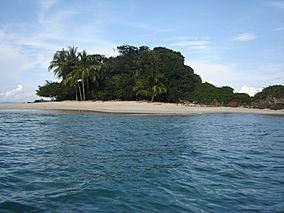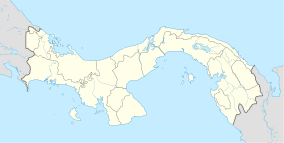Coiba facts for kids
Quick facts for kids Coiba National Park |
|
|---|---|
|
IUCN Category II (National Park)
|
|

Isla Granito de Oro, Coiba National Park
|
|
| Location | Chiriquí, Panama |
| Area | 503 km2 (194 sq mi) |
| Established | 1992 |
| Official name: Coiba National Park and its Special Zone of Marine Protection | |
| Type: | Natural |
| Criteria: | ix, x |
| Designated: | 2005 (29th session) |
| Reference #: | 1138rev |
| State Party: | Panama |
| Region: | Latin America and the Caribbean |
Coiba is the largest island in Central America. It covers about 503 square kilometers (194 square miles). This amazing island is located off the Pacific coast of Panama. It is part of the Chiriquí region.
Contents
History of Coiba
How Coiba Island Was Formed
Coiba Island became separate from mainland Panama a very long time ago. This happened between 12,000 and 18,000 years ago. At that time, sea levels rose, and the land connecting Coiba to the mainland went underwater.
Because of this, the plants and animals on Coiba became isolated. They could not mix with those on the mainland anymore. Over thousands of years, many animals on Coiba changed. They now look and act differently from their relatives on the mainland.
Unique Animals on Coiba
Coiba is home to many unique animals. These are called endemic subspecies. This means they are found only on Coiba Island. Some examples include:
- the Coiba Island howler monkey
- the Coiba agouti
- the Coiba spinetail (a type of bird)
The island is also one of the last places in Central America where you can find many scarlet macaws living in the wild.
Coiba's Past Residents
Coiba was once home to the Coiba Cacique Indians. Around 1560, they were taken over by the Spanish.
Later, in 1919, a prison was built on the island. For many years, this prison was known as a very tough place. It was used during the time when Panama was led by dictatorships. Because of the prison, most people avoided the island. This meant the island stayed wild and untouched.
The prison was closed down in 2004. After it closed, the island's natural beauty made it perfect for a nature reserve. Today, about 75% of Coiba Island is covered in forest. A large part of this is very old, ancient forest. Coiba also has types of trees that have disappeared from the mainland. This happened because of deforestation (cutting down forests) and too much harvesting.
Coiba National Park
In 1992, Panama decided to protect Coiba Island and its surroundings. They created the Coiba National Park. This park is huge, covering over 1,042 square miles. It includes islands, forests, beaches, mangrove swamps, and beautiful coral reefs.
In July 2005, Unesco recognized the park's importance. They declared it a World Heritage Site. This means it is a special place that should be protected for everyone.
What the Park Protects
Coiba National Park includes Coiba Island itself. It also protects 38 smaller islands nearby. All the ocean areas around these islands are part of the park too. These waters are in the Gulf of Chiriquí.
The park helps protect many amazing sea creatures, such as:
- Coral reefs
- Humpback whales
- Pilot whales
- Killer whales
- Dolphins
- Sea turtles
- Manta rays
- Marlins
The Gulf of Chiriquí helps protect the ocean life from big temperature changes. This means the marine ecosystems in Coiba National Park have a huge variety of life. The park is home to:
- 760 different kinds of marine fish
- 33 types of sharks
- 20 different kinds of cetaceans (like whales and dolphins)
See also

- In Spanish: Parque nacional Coiba para niños


